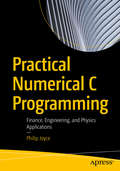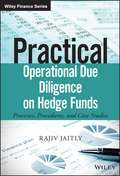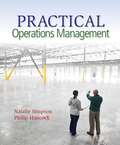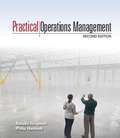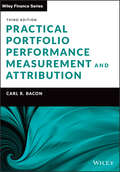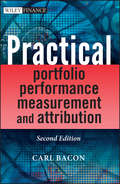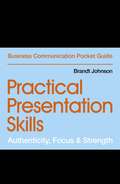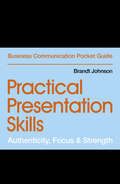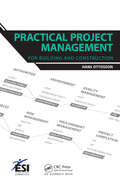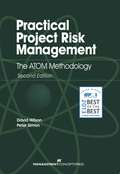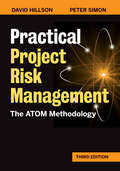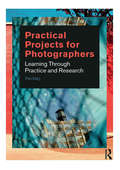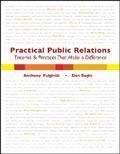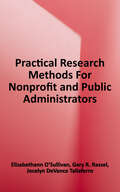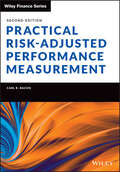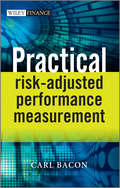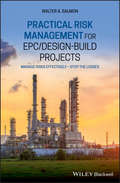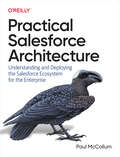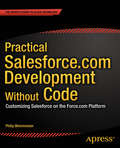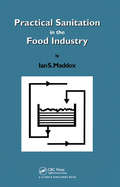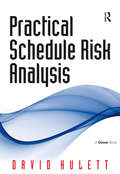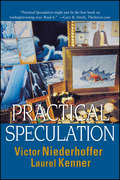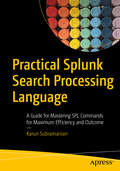- Table View
- List View
Practical Numerical C Programming: Finance, Engineering, and Physics Applications
by Philip JoyceMaster the C code appropriate for numerical methods and computational modeling, including syntax, loops, subroutines, and files. Then, this hands-on book dives into financial applications using regression models, product moment correlation coefficients, and asset pricing. Next, Practical Numerical C Programming covers applications for engineering/business such as supermarket stock reordering simulation as well as flight information boards at airports and controlling a power plant. Finally, the book concludes with some physics including building simulation models for energy and pendulum motion. Along the way, you’ll learn center-of-mass calculations, Brownian motion, and more. After reading and using this book, you'll come away with pragmatic case studies of actual applications using C code at work. Source code is freely available and includes the latest C20 standard release. What You Will Learn Apply regression techniques to find the pattern for depreciation of the value of cars over a period of years Work with the product moment correlation coefficient technique to illustrate the accuracy (or otherwise) of regression techniques Use the past stock values of an asset to predict what its future values may be using Monte Carlo methods Simulate the buying of supermarket stock by shoppers and check the remaining stock: if it is too low print a message to reorder the stock Create a file of arrivals for an airport and send data to the airport’s display boards to show the current situation for the incoming flights Simulate the patterns of particles moving in gases or solids Who This Book Is For Programmers and computational modelers with at least some prior experience with programming in C as well as programming in general.
Practical Operational Due Diligence on Hedge Funds
by Rajiv JaitlyTighten due diligence procedures for more successful hedge fund investment Practical Operational Due Diligence on Hedge Funds is an encyclopaedic, comprehensive reference, written from the perspective of an experienced practitioner. Accompanied by a useful archive of factual material on different hedge fund issues, including failures, fines, and closures, this book focuses on the areas due diligence professionals should address, and explains why they're important. Extensive discussion of publicised cases identifies the manager entities and actual fund vehicles involved, and provides commentary on what could have been done differently in each case, backed by actual regulatory materials, such as SEC complaints, that recreate the events that took place. Readers gain a deeper understanding of the many facets of due diligence and the many possible pitfalls, learning how standardise processes and avoid major errors and oversights. The amount of money managed by hedge funds has almost doubled from the $1 trillion under management at the time of the financial crisis. Hedge funds can be extremely risky, but can be extremely profitable -- as money increasingly flows back in, due diligence on these alternative investments becomes more and more critical. This book provides complete guidance toward the due diligence process, with plentiful real-world examples. Identify the areas of due diligence and what can go wrong Create procedures and checklists to minimise errors Learn what publicised cases could have done differently Gain a deeper understanding of massive failures and successes Proper due diligence can be a massive undertaking, but thoroughness is essential when the price of failure is so high. Practical Operational Due Diligence on Hedge Funds provides the details professionals need to be on point every time.
Practical Operations Management
by Philip G. Hancock Natalie C. SimpsonCollege Textbook for Introductory Operations Management courses
Practical Operations Management
by Natalie Simpson Philip HancockPractical Operations Management is an introductory Operations and Supply Chain Management text for undergrad or MBA courses. The text covers all basic Operations topics in 15 chapter, 575 pages. Includes linked scenario examples, questions, problems, cases, photos, references, four color graphics. Chapters average 35-40 pages. Second edition has expanded treatments of quality, supply chain partnering, strategy, and project management.
Practical Portfolio Performance Measurement and Attribution
by Carl R. BaconA practitioner's guide to the role and implications of performance measurement and attribution analysis in asset management firms Practical Portfolio Performance Measurement and Attribution is a comprehensive reference and guide to the use and calculation of performance returns in the investment decision process. Focusing on real-world application rather than academic theory, this highly practical book helps asset managers and investors determine return on assets, analyse portfolio behaviour and improve performance. Author Carl R. Bacon clearly describes each of the methodologies used by performance analysts in today's financial environment whilst sharing valuable insights drawn from his experience as a Director of Performance Measurement & Risk Control. The third edition is revised to reflect recent developments in performance attribution and presentation standards. Fully up-to-date chapters cover the entire performance measurement process, including return calculations, attribution methodologies, risk measures, manager selection and presentation of performance information. Written by an acknowledged leader in global investment performance standards, performance attribution technique and risk measurement Aligns with the publication of the 2020 Global Investment Performance Standards (GIPS®) Explains the mathematical aspects of performance measurement and attribution in a clear, easy-to-understand manner Provides numerous practical and worked examples of attribution analysis and risk calculations supported by Excel spreadsheets Includes signposts for the future development of performance measurement Practical Portfolio Performance Measurement and Attribution, Third Edition, remains a must-have for performance analysts and risk controllers, portfolio managers, compliance professionals and all asset managers, owners, consultants and servicing firms.
Practical Portfolio Performance Measurement and Attribution
by Carl R. BaconPerformance measurement and attribution are key tools in informing investment decisions and strategies. Performance measurement is the quality control of the investment decision process, enabling money managers to calculate return, understand the behaviour of a portfolio of assets, communicate with clients and determine how performance can be improved.Focusing on the practical use and calculation of performance returns rather than the academic background, Practical Portfolio Performance Measurement and Attribution provides a clear guide to the role and implications of these methods in today's financial environment, enabling readers to apply their knowledge with immediate effect.Fully updated from the first edition, this book covers key new developments such as fixed income attribution, attribution of derivative instruments and alternative investment strategies, leverage and short positions, risk-adjusted performance measures for hedge funds plus updates on presentation standards. Complete with a CD containing worked examples for the majority of exhibits, the book covers the mathematical aspects of the topic in an accessible and practical way, making this book an essential reference for anyone involved in asset management.
Practical Practice Math: Money Sense (REM 598E)
by Anne SattlerThis book intends to introduce students to the vital role that money handling plays in all areas of a person's life, while reinforcing basic math skills through a variety of problem-solving exercises. Comprehension, logical thinking, and sequential decisions are required to find answers to word problems relating to situations regarding money matters.
Practical Presentation Skills: Authenticity, Focus & Strength
by Brandt JohnsonDeliver compelling presentations in any context, from a meeting with colleagues to a client pitch or keynote address.Whenever you talk to anyone, you are presenting yourself and your ideas to an audience. You are giving a presentation. This could be in person, on the phone, or via videoconference. In any case, both your content and your delivery contribute to the vitality and effectiveness of your message. Too many speakers fail to engage their audience and get their ideas across. Don't be one of them! Practical Presentation Skills will help you master the three fundamental elements responsible for a presentation's success: authenticity, focus, and strength.
Practical Presentation Skills: Authenticity, Focus & Strength (Business Communication Pocket Guides)
by Brandt JohnsonDeliver compelling presentations in any context, from a meeting with colleagues to a client pitch or keynote address.Whenever you talk to anyone, you are presenting yourself and your ideas to an audience. You are giving a presentation. This could be in person, on the phone, or via videoconference. In any case, both your content and your delivery contribute to the vitality and effectiveness of your message. Too many speakers fail to engage their audience and get their ideas across. Don't be one of them! Practical Presentation Skills will help you master the three fundamental elements responsible for a presentation's success: authenticity, focus, and strength.
Practical Problem-Solving Skills in the Workplace
by Judith Combes Taylor Rebekah LashmanProblem-solving skills to identify and resolve work-related problems and improve job performance. With the increasing emphasis on initiative in the workplace, it‘s essential to know how to recognize, define, and analyze problems and then develop workable solutions to correct them. This book provides all the skills needed to achieve this, including a problem-solving tree. Readers will learn how to: • Evaluate your own problem-solving strengths and weaknesses • Use problem-solving skills to identify and resolve work-related problems and improve your job performance • Track the steps you need to solve work-related problems with the Problem-Solving Tree. This is an ebook version of the AMA Self-Study course. If you want to take the course for credit you need to either purchase a hard copy of the course through amaselfstudy.org or purchase an online version of the course through www.flexstudy.com.
Practical Project Management for Building and Construction: Practical Project Management For Building And Construction (Esi International Project Management Ser. #11)
by Hans OttossonPractical Project Management for Building and Construction covers the 14 knowledge areas of project management that are essential for successful projects in the construction industry. For each knowledge area, it explains the processes for scope, time, risk, cost, and resource management. Filled with work and process flow diagrams, it demonstrates h
Practical Project Risk Management: The ATOM Methodology
by David HillsonThis second edition of the book reflects the authors' work to continually improve upon the model and to apply the methodology to a broader range of issues. The book includes:• An entirely new chapter on managing risk in programs, which is an important dimension in today's world of ever more complex initiatives• Updated material and methodology more closely aligned with relevant international standards• Emphasis on minimizing the threats and maximizing the opportunities to optimize achievement of your project goalsBased on sound principles and best practices, this book guides any member of the project management team in conducting risk management in a real-world environment.
Practical Project Risk Management, Third Edition: The ATOM Methodology
by David Hillson Peter SimonThis new edition of an award-winning risk management classic is more actionable than ever with new chapters on facilitating risk conversations and running a risk workshop. Risk isn't just about threat; it's also about opportunity. You have to be ready to take advantage of the most unexpected events—good or bad—with any project you are managing. But how does this work in practice? The Active Threat and Opportunity Management (ATOM) methodology offers a simple, scalable risk process that applies to all projects in all industries and business sectors. For each process step, the authors offer practical advice, hints, and tips on how to get the most out of the risk management process. Risk management really can work in practice. This Project Management Institute award-winning methodology is already used by top corporations. Whether you are someone with no prior knowledge of risk management or someone who simply needs guidance on how to apply risk management successfully, this book will help you tackle the ups and downs of this unpredictable world.
Practical Projects for Photographers: Learning Through Practice and Research
by Tim DalyExpert photographer and instructor Tim Daly presents over 20 practical projects for the budding photographer to develop their technical and research skills.Each project is a ready-made resource - the assignments vary in size and complexity, exploring a wide range of outputs (print, photobook, blog) and are mindful of limited resources, travelling distances and access to expensive equipment. Within each section are examples of notable photographers from around the world, suggested responses, practice tips, readings from key thinkers and further resources. This book blends understanding of context and technique to help photographers find new ways to work through the creative process.
Practical Public Relations: Theories and Techniques That Make a Difference
by Anthony Fulginiti Don BaginPublic relations is story telling. Persons and organizations have the right to tell their sides of the story. It's a constitutionally protected activity, like journalism and advertising. But public relations differs from journalism because it openly advocates for clients and organizations. And PR differs from advertising because it must earn, purchase, the reputation so important to organizations. Public relations practitioners are both counselors and communicators. They both fashion and send information persuasive messages to important audiences. They're responsible for maintaining the relationships between their organizations and their important publics.
Practical Research Methods for Nonprofit and Public Administrators
by Elizabethann O'Sullivan Gary R. Rassel Jocelyn DeVance TaliaferroOrganized around the four types of studies typically conducted by effective managers and programs, Practical Research Methods for Nonprofit and Public Administrators integrates traditional research methods topics with specific management applications. This unique text includes extensive end-of-chapter exercises highlighting the importance of qualitative methods and emphasizing practical skills managers should be able to easily and correctly apply.
Practical Risk-Adjusted Performance Measurement (The Wiley Finance Series)
by Carl R. BaconExplore different measures of ex-post risk-adjusted performance measurement and learn to choose the correct one In the newly revised Second Edition of Practical Risk-Adjusted Performance Measurement, accomplished risk and investment expert Carl R. Bacon delivers an insightful, accessible, and real-world guide to ex-post risk measurement. The author bridges the gap between theory and practice, showing you how to apply the former to the latter without introducing unnecessary mathematical complexity. The book describes the fundamentals of risk in the asset management context and the descriptive statistics used to describe it. It builds on that foundation with detailed examinations of concepts like regression, drawdown, and partial moments, before moving on to topics like fixed income risk and Prospect Theory. With helpful additions that include recently developed measures of risk, supplementary explanatory sections, and six brand-new chapters, this book also offers: A practical classification of all ex-post risk measures and how they connect to one another An explanation of how risk-adjusted performance measures impact performance fees A discussion of risk measure dashboard designs Instructions on how appraisal measures should be used for manager selection Perfect for portfolio managers, asset owners, risk controllers, and investment performance analysts, Practical Risk-Adjusted Performance Measurement is an indispensable resource for anyone looking for a hands-on exploration of the buy-side, asset management perspective.
Practical Risk-Adjusted Performance Measurement
by Carl R. BaconA practitioner's guide to ex-post performance measurement techniquesRisk within asset management firms has an undeserved reputation for being an overly complex, mathematical subject. This book simplifies the subject and demonstrates with practical examples that risk is perfectly straightforward and not as complicated as it might seem. Unlike most books written on portfolio risk, which generally focus on ex-ante risk from an academic perspective using complicated language and no worked examples, this book focuses on ex-post risk from a buy side, asset management, risk practitioners perspective, including a number of practical worked examples for risk measures and their interpretation.
Practical Risk Management for EPC / Design-Build Projects: Manage Risks Effectively - Stop the Losses
by Walter A. SalmonMany of the books on construction risk management concentrate on theoretical approaches to the accurate assessment of the overall risks of taking on a new project. Less attention is paid to the typical risks to which the operational level of a project is exposed and how operational managers should approach those risks during project implementation. This book identifies precisely where the major EPC/Design-Build risks occur within an operational framework and shows how best to deal with those risks. The book attempts to offer practical advice, approaches and tools for dealing with risks to which the various operational departments are exposed.
Practical Salesforce Architecture: Understanding and Deploying the Salesforce Ecosystem for the Enterprise
by Paul McCollumOnce renowned as a customer relationship management tool, Salesforce has evolved into a cloud-first application and capability ecosystem. With dedicated components for tasks such as middleware, big data, reporting, ETL, data loading, and API orchestration, Salesforce has become more prevalent in modern architectures.This concise yet comprehensive guide provides an overview of Salesforce architecture for enterprise architects and Salesforce ecosystem architects. Author Paul McCollum, Salesforce Technical Architect at Accenture, provides a roadmap for integrating major elements of the Salesforce ecosystem with planned or existing enterprise architecture. You'll learn how to use these components to address the diverse needs of different organizations.Many companies today are adding or building multicloud capabilities and incorporating various elements from the Salesforce ecosystem. With this book, you'll learn:Strengths, weaknesses, and growth areas of Salesforce's enterprise architecture domain featuresHow Salesforce compares to other cloud providersMethods for using the Salesforce ecosystem effectively to address your organization's needsHow to integrate Salesforce with planned or existing enterprise architecturesWays to manage and forecast performance, complexity, and ease of operation across the Salesforce platform
Practical Salesforce.com Development Without Code
by Philip WeinmeisterAre you facing a challenging Salesforce. com problem--say, relating to automation, configuration, formulation, or reporting--that you can't quite crack? Or maybe you are hoping to infuse some creativity into your solution design strategy to solve problems faster or make solutions more efficient? Practical Salesforce. com Development Without Code shows you how to unlock the power of the Force. com platform to solve real business problems--and all without writing a line of code. Adhering to Salesforce. com's 'clicks, not code' mantra, Salesforce. com expert Phil Weinmeister walks you through different business problems and identifies effective, creative--and proven--approaches to solutions using the platform's declarative framework. If you are a Salesforce. com administrator, analyst, consultant, or developer, you can attest to the insatiable appetite of users for new functionality. Your clients expect solutions--and now. By adopting Practical Salesforce. com Development Without Code as your guide, you will learn how to deliver business solutions within Salesforce. com by combining analysis, creativity, and logic with some of its core elements, including validation rules, workflow rules, and formula fields. In addition, Weinmeister dissects and explains the most useful functions and features for developers, and shows you how to use them. Among other things, you will learn how to: Build objects, fields, and relationships to establish a sensible data modelAutomate business processes by using workflow rules and flows (Visual Workflow)Utilize functions and develop formulas effectively for a variety of business needsDevelop intricate approval processes to handle exception scenariosEmploy publisher actions to drive additional functionality from the Chatter feedManage your data using Data LoaderBest of all, Weinmeister uses real-life business scenarios and visuals to keep you engaged and learning something new with every page you read. Practical Salesforce. com Development Without Code will help you absorb the principles behind dozens of creative and thoughtful ways to solve your business problems. Applying the lessons learned from this how-to guide will ultimately save you time and ensure that your clients or internal customers are well satisfied and productive
Practical Sanitation in the Food Industry
by Ian S. MaddoxThis book provides a clear, practical approach to sanitation in the food industry. The content ranges from the principles of microbial growth, through descriptions of cleaning chemicals, to the management of Hazard Analysis Critical Control Point (HACCP) systems. It will be an invaluable basic text for all tertiary students who intend to work in the food industry, as well as for the existing industry personnel.
Practical Schedule Risk Analysis
by David HulettProject scheduling is required for good project management, and the schedule represents the project plan under a specific set of assumptions, often that it will avoid new risks or even those that have occurred on previous occasions. The typical Critical Path Method (CPM) schedule assumes that the project team knows how long the scheduled activities will take. Yet, the experienced project manager knows that duration values so precisely stated are actually only estimates based on assumptions that could be wrong. A schedule risk analysis explores the implications for the project's schedule of risk to the activity durations and also identifies the most important schedule risks. This analysis, building on and extending CPM scheduling, will result in a more accurate estimate of completion and provide an early opportunity for planning effective risk mitigation actions. Practical Schedule Risk Analysis contains a complete treatment of schedule risk analysis from basic to advanced concepts. The methods are introduced at the simplest level: * Why is the duration uncertain? * And how do we represent this uncertainty with a probability distribution? These are then progressively elaborated: * How does uncertainty of activities along a path lead to more uncertainty of the path's completion date? * How can a schedule with parallel paths be riskier than each of the paths individually? * How can we represent risks about activities that are not in the schedule at all? Culminating in a discussion of the most powerful and advanced capabilities available in current commercial software. Schedule risk analysis is a process that is industry-independent, and the methods explained in this volume have been used by the author with positive effect in such industries as construction, oil and gas, information systems, environmental restoration and aerospace/defense. The result is a book that is not only highly practical; something that people within all types of projects and in all industries can apply themselves; but that is an extraordinarily complete guide to creating and managing a rigorous project schedule.
Practical Speculation
by Victor Niederhoffer Laurel KennerThe follow-up to Victor Niederhoffer's critically and commercially acclaimed book The Education of a Speculator has finally arrived. Practical Speculation continues the story of a true market legend who ran a hugely successful futures trading firm that had annual returns of over thirty percent until unforeseen losses forced him to close operations. Like a phoenix rising from the ashes, Niederhoffer returned to the world of trading stocks, futures, and options, with a new colleague and a new approach and found success. Order your copy of this compelling story of risk and survival today.
Practical Splunk Search Processing Language: A Guide for Mastering SPL Commands for Maximum Efficiency and Outcome
by Karun SubramanianUse this practical guide to the Splunk operational data intelligence platform to search, visualize, and analyze petabyte-scale, unstructured machine data. Get to the heart of the platform and use the Search Processing Language (SPL) tool to query the platform to find the answers you need. With more than 140 commands, SPL gives you the power to ask any question of machine data. However, many users (both newbies and experienced users) find the language difficult to grasp and complex. This book takes you through the basics of SPL using plenty of hands-on examples and emphasizes the most impactful SPL commands (such as eval, stats, and timechart). You will understand the most efficient ways to query Splunk (such as learning the drawbacks of subsearches and join, and why it makes sense to use tstats). You will be introduced to lesser-known commands that can be very useful, such as using the command rex to extract fields and erex to generate regular expressions automatically. In addition, you will learn how to create basic visualizations (such as charts and tables) and use prescriptive guidance on search optimization. For those ready to take it to the next level, the author introduces advanced commands such as predict, kmeans, and cluster.What You Will LearnUse real-world scenarios (such as analyzing a web access log) to search, group, correlate, and create reports using SPL commandsEnhance your search results using lookups and create new lookup tables using SPL commandsExtract fields from your search results Compare data from multiple time frames in one chart (such as comparing your current day application performance to the average of the past 30 days) Analyze the performance of your search using Job Inspector and identify execution costs of various components of your search Who This Book Is ForApplication developers, architects, DevOps engineers, application support engineers, network operations center analysts, security operations center (SOC) analysts, and cyber security professionals who use Splunk to search and analyze their machine data
